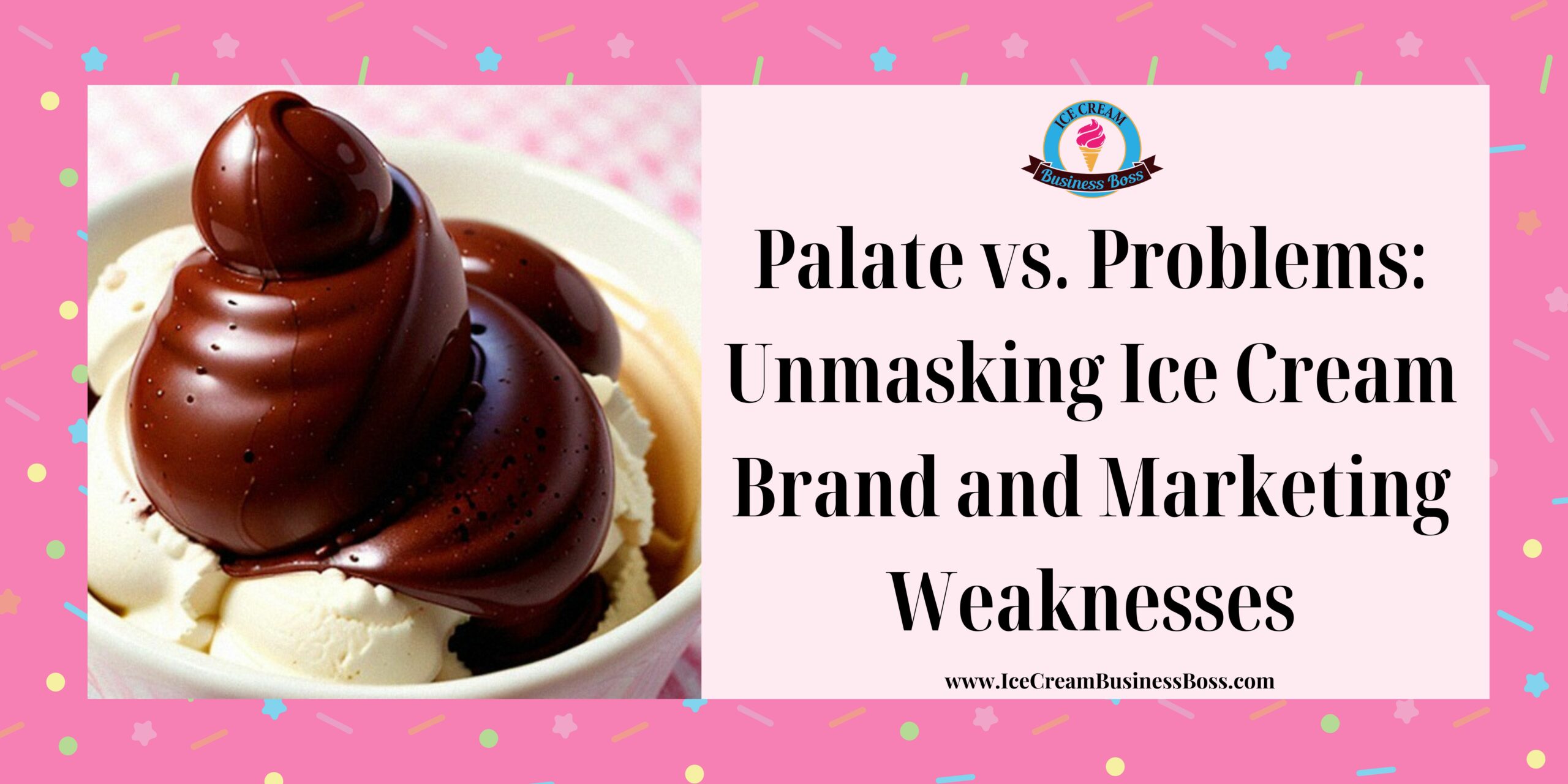A scoop of creamy, delicious ice cream is a timeless pleasure that transcends age, culture, and time. The temptation of this frozen delight is unmistakable, but underlying the sweetness is a complex landscape of problems that ice cream manufacturers and their marketing tactics must tackle. The world of ice cream branding and marketing is far from immune to vulnerabilities, from the ebb and flow of consumer demand to the changing health-conscious mindset, from tough rivalry to the dynamic preferences of customers.
To effectively address challenges, you should possess a comprehensive understanding of ice cream brands’ or marketing weaknesses, which encompass factors such as seasonality, health-related concerns, intense competition, and ever-evolving consumer preferences.
Understanding Seasonality: A Frozen Challenge
The seasonality of consumers’ favorite frozen desserts presents an important and persistent challenge for ice cream businesses. This ongoing problem results from the erratic patterns of ice cream consumption, which peak in the warm months and go off in the colder ones. For brands, this demand seesaw creates a unique and challenging conundrum that forces them to plan innovative strategies to maintain consumer engagement and sales throughout the year.
Given this situation, the need for creative approaches becomes readily evident. Brands must cleverly take advantage of the shifting seasons by highlighting their distinctive qualities. Introducing seasonal cuisines that go well with joyous holidays and special occasions is a crucial strategy.
For example, creating ice cream creations that conjure up the coziness of Thanksgiving or the joyous atmosphere of Christmas can build a compelling story that encourages consumers to indulge regardless of the time of year. By incorporating ice cream consumption into the very fabric of these celebrations, this strategy takes advantage of the emotional connections people have with these events.
In addition to including seasonal flavors, marketers can reframe consumers’ perceptions of ice cream as an all-year-round treat by using creative marketing strategies. Companies may expertly present ice cream as a versatile delicacy fit for every occasion, regardless of the temperature, by embracing inventive storytelling and imagery. Seasonal barriers can no longer be an impediment to consumer preferences thanks to marketing campaigns that highlight the fun of sharing an ice cream cone in the winter or curling up with a pint by the fire in the fall.
Strategic partnerships with businesses and brands that complement one another can increase ice cream’s appeal all year long. You can appeal to a variety of consumer interests by working with coffee shops to create intriguing affogato variations or with bakeries to create delectable ice cream sandwiches. Regardless of the weather, these partnerships can increase anticipation and excitement, which will increase demand.
Confronting Health-Related Concerns

The way people analyze their dietary choices has undergone a significant transition in the modern era due to a rise in health consciousness. This astute eye has not escaped the classic delight of ice cream. Ice cream firms have been thrown into the spotlight of adaptation due to the constantly growing worry about health-related aspects, particularly the formidable foes of elevated sugar levels and calorie counts. The challenge for these businesses is to transform their offers to fit with changing desires while preserving the prized qualities of flavor and quality as a growing segment of consumers migrate toward healthier options.
A delicate balance develops in the hub of this dynamic shift. The challenge at hand demands a harmonic marriage of health-conscious innovation with unashamed enjoyment, which is at the very heart of ice cream’s charm. The growth of ice cream brands in the current health-focused era pivots to achieving this balance. To traverse this environment, firms must adopt complex strategies that combine the search for healthy substitutes with the protection of the heartwarming delight that ice cream embodies.
The idea of transparency is essential to these tactics. Ice cream businesses give customers clear and intelligent labeling so they may make decisions that are in line with their health objectives. A clear display of nutritional facts enables people to determine the amount of sugar, calories, and other relevant information, supporting thoughtful decisions without sacrificing enjoyment from consumption.
Altering the ingredients is another crucial avenue for brand evolution. To satisfy a wide range of interests, manufacturers can do so by experimenting with novel formulas that incorporate healthy ingredients while maintaining the decadent textures and mouthwatering flavors associated with ice cream. For instance, low-sugar varieties satisfy the craving for a sweet treat without overdosing customers on sugar.
The emergence of dairy-free and plant-based substitutes is a sign of the industry’s quick response to modern dietary demands. Businesses that traverse this market by creating non-dairy ice creams that mimic the creamy delight of their dairy counterparts have the chance to appeal to a completely new group of health-conscious consumers.
Navigating Intense Competition

The market for ice cream in the world of frozen treats emerges as a battleground rife with severe competition, where a variety of firms go on an unceasing search for customer attention. The competition extends beyond the wide range of flavors to the area of distinctiveness through differentiating selling points, creative packaging, and astute marketing strategies.
Failure to establish a distinctive presence in this environment of intense competition might potentially cause a brand to stagnate or even lose its desired market share. The unwavering way for ice cream manufacturers to overcome this daunting task is to embrace the art of developing a determined brand identity, one that resonates in harmony with the rhythm of their target consumers.
The engaging story that a brand crafts is essential to this attempt. Ice cream firms may transcend the commonplace by positioning themselves as makers of experiences rather than merely sellers of goods thanks to the tapestry of narrative.
They can provide their offerings with a distinctive aura that enticingly attracts the attention of customers by exploring the history, ethos, or cultural inspiration behind their brand. This story ends up being what distinguishes them most, forging a bond that goes beyond the transactional nature of consumption.
However, storytelling isn’t the only note in the symphony of brand difference that rings true. Conscious sustainability activities amplify the resonant chords. Ice cream firms that embrace eco-friendly methods, from sourcing ethically produced ingredients to adopting sustainable packaging, align themselves with the ideals of a growing generation in a world where environmental consciousness is increasingly defining consumer choices. This sustainability not only fits with the current attitude but also acts as a salient differentiation, drawing in aware customers looking for firms that share their concerns.
Establishing relationships with local communities is an orchestral movement with the potential for powerful resonance. Brands get a sense of place through partnerships with regional farmers, craftspeople, and artists, which endears them to the communities they serve. This bond can give the company legitimacy, enabling it to move beyond the transactional and establish itself as a community staple.
Adapting to Ever-Evolving Consumer Preferences

The panorama of consumer preferences is always changing due to shifting lifestyles, societal shifts, and the emergence of new trends. To be relevant and captivating in the eyes of customers, ice cream brands must navigate the currents of change within this dynamic environment. The danger of losing consumer resonance as a result of failing to anticipate or adapt to these developments, however, looms in the background.
A discordant note appears when a brand’s offers are out of step with the rhythm of consumers’ changing preferences, potentially creating a rift between the product and the customer. Ice cream brands must embark on a journey of vigilance, understanding, and proactive adaptation to address this challenge.
The resonant notes of market research and trend analysis set the stage for the growth symphony. Brands that devote time and money to comprehending consumers’ dynamic patterns of behavior and desires are those that are situated on the cusp of shifting consumer preferences. Brands may arm themselves with the compass to traverse this constantly shifting landscape by closely observing social dynamics, keeping tabs on new lifestyle trends, and watching the rise of innovative cultural phenomena.
With this compass in hand, the launch of novel flavors, fresh product lines, and creative package forms pave the way to relevance. It is the epitome of flexibility and agility, where businesses plan the change of their products and services to meet the changing needs of their customers.
When a preference for plant-based foods emerges, ice cream companies that promote dairy-free options raise a flag of inclusivity that welcomes both lactose-intolerant customers and those who value the environment. Similar to how artisanal and locally sourced products are growing in popularity, brands that change their strategies to include these components in their products appeal to a generation that values authenticity and sustainability.
The driving force that connects businesses and consumers is now proactive behavior. Brands move beyond the role of passive participants and become trend creators rather than merely trend followers by forecasting what the future will need. The results exhibit keen foresight, catching the zeitgeist and elevating the brand to a position of significance.
The Power of Comprehensive Understanding
A guiding theme emerges from the complex web of issues that characterize the ice cream industry and its marketing tactics: understanding vulnerabilities is the key to achievement. The environment that ice cream manufacturers must operate in is intricately woven by the interaction of several factors, including seasonality, health-related concerns, severe competition, and the shifting nature of consumer tastes.
Recognizing these difficulties and cleverly coming up with methods to overcome them becomes the compass pointing brands toward not just surviving but also prospering in the relentless and fiercely competitive ice cream market.
Seasonality carries with it both opportunity and difficulty, just like the changing seasons themselves. The peak of ice cream consumption occurs throughout the hot months, while a decline begins during the colder months. By utilizing the attraction of seasonal flavors, limited-time offers, or marketing efforts that reframe ice cream as a treat for all seasons, marketers can design strategies to offset the slump as a result of this intrinsic pattern. Understanding the cyclical dance of consumer needs and taking advantage of the sentimental connotations associated with each season is key to this transformation from limitation to benefit.
Concerns regarding the amount of sugar and calories in ice cream have been raised as a result of the rising popularity of health consciousness. Brands can reframe this as a stimulus for innovation rather than seeing it as an insurmountable obstacle. Without compromising on taste, producers can satisfy a wide range of consumer preferences by developing lower-sugar, dairy-free, or even nutritionally fortified choices. Ice cream producers can reconcile enjoyment with wellness by portraying these substitutes as part of a larger story about a brand’s dedication to health.
Brands are required to stand out in the ruthless and very competitive marketplace. This is a comprehensive effort that includes innovative selling propositions, packaging improvements, and strategic marketing rather than just a flavor competition. To carve out a niche, bring to life a brand’s personality, and invite customers into an experience that resonates beyond the goods, it is crucial to have a keen grasp of rival landscapes.
The trends in consumer tastes are constantly changing as a result of shifting cultural dynamics and new fashions. If a brand doesn’t change with the times, it could become obsolete. Utilizing trend analysis, firms may foresee consumer trends and create products that cater to them. A brand is better able to design memorable experiences when it is aware of the aspirations, values, and preferences of its target market.
Frequently Asked Questions
What are the primary marketing issues that ice cream brands face?
Ice cream companies face several hurdles in their marketing efforts. Seasonality, where demand changes with changing weather; health-related concerns such as high sugar content; severe competition from multiple brands; and the need to adapt to ever-changing consumer preferences are among these challenges. These issues can have an impact on brand achievement and require strategic ways to address them effectively.
How can ice cream companies effectively address health issues while maintaining taste and quality?
Ice cream companies can take a variety of measures to address health concerns. To appeal to health-conscious consumers, they can provide low-sugar or dairy-free alternatives. Consumer trust can be built by transparent labeling and explicit discussion regarding substances. Marketers can concentrate on striking a balance between healthy alternatives and the luxurious experience that ice cream offers, thereby meeting both taste and health preferences.
How can ice cream brands differentiate themselves in a crowded market and adapt to changing consumer preferences?
Standing out in a crowded marketplace necessitates a strong brand identity and distinctiveness. Brands may accomplish this by using storytelling, sustainability initiatives, and collaborations that connect emotionally with consumers. Continuous market research and trend analysis are required to adapt to changing customer tastes, allowing brands to provide unique flavors, packaging, and product lines that correspond with emerging trends and assure ongoing consumer involvement.
The information provided by IceCreamBusinessBoss.com (“The Site”) is for general informational purposes only. All information on the Site is provided in good faith, however, we make no representation or warranty of any kind, express or implied, regarding the accuracy, adequacy, validity, reliability, availability, or completeness of any information on the Site. Under no circumstance shall we have any liability to you for any loss or damage of any kind incurred as a result of the use of the Site or Reliance on any information provided on the Site. Your use of the Site and your reliance on any information on the Site is solely at your own risk. This blog post is for educational purposes only and does not constitute legal advice. Please consult a legal expert to address your specific needs. Terms and Conditions.

Hi! I am Shawn and I am a happy individual who happens to be an entrepreneur. I have owned several types of businesses in my life from a coffee shop to an import and export business to an online review business plus a few more and now I create online ice cream/gelato business resources for those interested in starting new ventures. It’s demanding work but I love it. I do it for those passionate about their business and their goals. That’s why when I meet a ice cream/gelato business owner, I see myself. I know how hard the struggle is to retain clients, find good employees and keep the business growing all while trying to stay competitive.
That’s why I created Ice Cream Business Boss: I want to help ice cream and gelato business owners like you build a thriving business that brings you endless joy and supports your ideal lifestyle.

